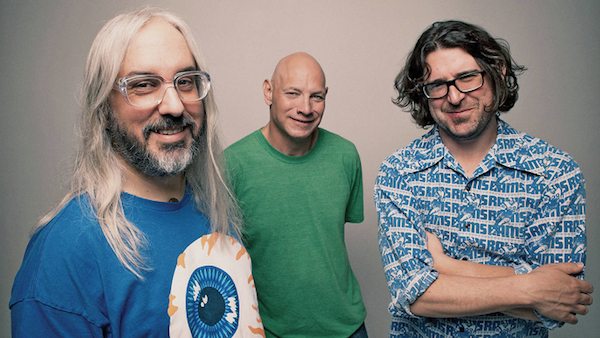Movie review by Greg Carlson
With the documentary feature “Freakscene: The Story of Dinosaur Jr.,”director Philipp Reichenheim (who also uses the handle Philipp Virus) compiles a serviceable primer on the wall of sound produced by one of the seminal power trios of 1980s independent/DIY music. In the 90s, the band would go on to near-mainstream success during the ascendancy of “alternative” rock in the wake of Nirvana’s massive crossover appeal, via regular rotation on MTV programming like “120 Minutes.” Tracking some of the aesthetics of units like Hüsker Dü and the Pixies, who perfected the loud-quiet-loud dynamic that would inspire so much of Kurt Cobain’s songwriting, Dinosaur Jr. combined beautiful melodies with punishing sheets of distortion and feedback.
Reichenheim is the brother-in-law of Dinosaur bandleader J Mascis, and the proximity affords comprehensive access to the substantial trove of archival photography and video that fans will comb for glimpses of favorite performances and previously unseen surprises. “Freakscene” is not, however, structured primarily as a deep critical assessment of the group’s musical output and evolution, even though a pretty straightforward chronological account of key recordings guides the narrative. Instead, Reichenheim foregrounds solo talking-head interviews with the notoriously taciturn Mascis, bass player (and Sebadoh and Folk Implosion architect) Lou Barlow, and drummer Murph, who all spend more time recounting frustrations, struggles and disappointments than they do acknowledging peaks and triumphs.
This “no fun” theme contributes to an appropriately grumpy tone, perfectly complemented by the white and gray winter snowscapes in and around Amherst, Massachusetts, where Mascis was born and still resides. Eventually switching from percussion to guitar, Mascis surprised Barlow – who was certain his fellow hardcore Deep Wound bandmate hated him – by asking him to join Dinosaur. Over the next several years, the band’s commitment to ear-splitting volume, combined with what Barlow describes as the “purity” of Mascis’s far-ranging vision, led to a place at SST and the release in 1987 of “You’re Living All Over Me,” which built the fanbase by leaps and bounds.
In addition to new listeners, the increasingly skillful guitar wizardry practiced by Mascis drew fellow musicians to the Dinosaur enterprise. Sonic Youth, known for championing and nurturing up-and-coming artists, recognized something special. Both Kim Gordon and Thurston Moore appear in “Freakscene,” along with vintage footage shot on tour by Lee Ranaldo. And while the interview subjects rarely dig into specifics beyond the expected construction of band-as-dysfunctional-family, the presence of luminaries like Bob Mould, Frank Black, Kevin Shields, Henry Rollins, Kurt Vile, and Megan and Maura Jasper broadens the film’s appeal.
During the movie’s fleet running time, a great many aspects of Dinosaur Jr. are treated casually, offhandedly, or are skipped altogether. There is no doubt that some longtime followers would have salivated over a deeper dive into the details of songcraft and lyrics, but Reichenheim matches the content of his film to the personality of the band being profiled. In other words, Mascis largely remains an enigma, even following a confessional description of fatherhood and his personal journey toward Hindu spiritualism. One imagines, however, that the soft-spoken composer remains quite content to speak through the music.
Sometimes, I don’t thrill you
Sometimes, I think I’ll kill you
Just don’t let me fuck up, will you
‘Cause when I need a friend it’s still you
